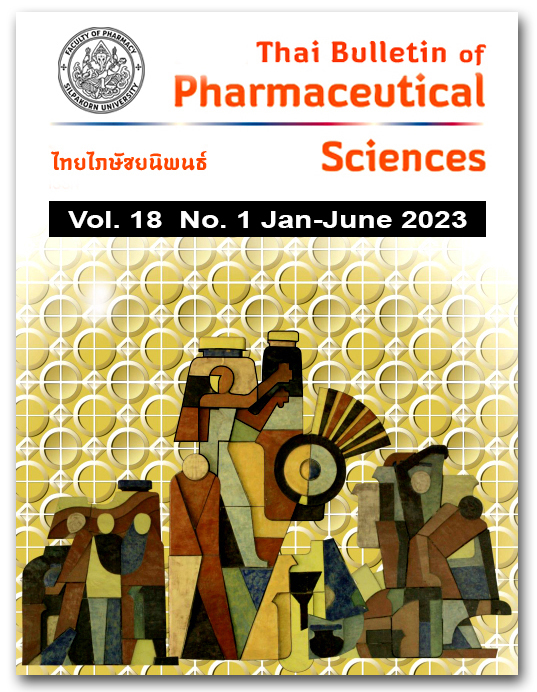A RETROSPECTIVE STUDY OF THE EFFECTIVENESS OF SGLT-2 INHIBITORS IN PATIENTS WITH UNCONTROLLED TYPE 2 DIABETES MELLITUS TREATED WITH NON-SGLT-2 INHIBITORS
DOI:
https://doi.org/10.69598/tbps.18.1.29-40Keywords:
type 2 diabetes mellitus, dapagliflozin, empagliflozin, FPG, HbA1CAbstract
Type 2 diabetes is the 5th highest chronic non-communicable disease in Thailand. Therefore, antidiabetic drugs were developed to increase the effectiveness in controlling blood sugar and to reduce the side effects. This study aimed to compare the efficacy of dapagliflozin and empagliflozin in reducing fasting plasma glucose (FPG), glycated hemoglobin (hemoglobin A1c; HbA1C), and body weight at 3, 6, 9, and 12 months in patients with type 2 diabetes. This retrospective study enrolled 900 type 2 diabetes patients at the Central Chest Institute of Thailand from October 2014 to October 2019. The patients were divided into three groups. The first group was treated with dapagliflozin. The second group was treated with empagliflozin. The third group was treated with non-SGLT-2 inhibitors. For the efficacy, we found that 18.18%, 18.71%, and 1.52% of the patients who were treated with dapagliflozin, empagliflozin, and non-SGLT-2 inhibitors, respectively, had a reduction in FPG at three months. For the efficacy, we found that 6.98%, 8.24%, and 1.41% of the patients who were treated with dapagliflozin, empagliflozin, and non-SGLT-2 inhibitors, respectively, had a reduction in HbA1C at three months. For the efficacy, we found that 1.50%, 1.84%, and 1.32% of the patients who were treated with dapagliflozin, empagliflozin, and non-SGLT-2 inhibitors, respectively, had a reduction in body weight at three months. We found that a reduction of FPG, HbA1C, and body weight were significantly lower in patients who were treated with SGLT-2 inhibitors than those who were treated with non-SGLT-2 inhibitors (p-value < 0.001).
References
Pratipanawatr T, Rawdaree P, Chetthakul T, Bunnag P, Ngarmukos C, Benjasuratwong Y, et al. Thailand Diabetic Registry cohort: predicting death in Thai diabetic patients and causes of death. J Med Assoc Thai. 2010;93(Suppl 3):S12-20.
Thomas MC, Cherney DZ. The actions of SGLT2 inhibitors on metabolism, renal function and blood pressure. Diabetologia. 2018;61(10):2098-107.
Zelniker TA, Wiviott SD, Raz I, Im K, Goodrich EL, Bonaca MP, et al. SGLT2 inhibitors for primary and secondary prevention of cardiovascular and renal outcomes in type 2 diabetes: a systematic review and meta-analysis of cardiovascular outcome trials. The Lancet. 2019;393(10166):31-9.
American Diabetes Association. 9. Pharmacologic approaches to glycemic treatment: standards of medical care in diabetes-2020. Diabetes Care. 2020;43(Suppl 1):S98-110.
Diabetes Association of Thailand under The Patronage of Her Royal Highness Princess Maha Chakri Sirindhorn. Clinical Practice Guideline for Diabetes 2017. Bangkok: Srimuang publishing; 2017. (in Thai)
Hussain M, Elahi A, Iqbal J, Ghafoor MB, Rehman H, Akhtar S. Comparison of efficacy and safety profile of sodium-glucose cotransporter-2 inhibitors as add-on therapy in patients with type 2 diabetes. Cureus. 2021;13(4).
Thewjitcharoen Y, Yenseung N, Malidaeng A, Nakasatien S,
Chotwanvirat P, Krittiyawong S, et al. Effectiveness of long-term treatment with SGLT2 inhibitors: real-world evidence from a specialized diabetes center. Diabetol Metab Syndr. 2017;9(1):1-8.
Sacks DB, Bruns DE, Goldstein DE, Maclaren NK, McDonald JM, Parrott M. Guidelines and recommendations for laboratory analysis in the diagnosis and management of diabetes mellitus. Clin Chem. 2002;48(3):436-72.
World Health Organization. Tenth Revision Thai Modification. ICD-10-TM: international statistical classification of diseases and related health problems. 10th Revision Thai Modification. Thailand: Ministry of Public Health; 2011. (in Thai)
Bausell RB, Li YF. Power analysis for experimental research: a practical guide for the biological, medical and social sciences. Cambridge University Press; 2002 Sep 19.
Lin YH, Huang YY, Hsieh SH, Sun JH, Chen ST, Lin CH. Renal and glucose-lowering effects of empagliflozin and dapagliflozin in different chronic kidney disease stages. Front Endocrinol. 2019;10:820.
Ku EJ, Lee DH, Jeon HJ, Oh TK. Empagliflozin versus dapagliflozin in patients with type 2 diabetes inadequately controlled with metformin, glimepiride and dipeptidyl peptide 4 inhibitors: a 52-week prospective observational study. Diabetes Res Clin Pract. 2019;151:65-73.
List JF, Woo V, Morales E, Tang W, Fiedorek FT. Sodium-glucose cotransport inhibition with dapagliflozin in type 2 diabetes. Diabetes care. 2009;32(4):650-7.
Zhang YJ, Han SL, Sun XF, Wang SX, Wang HY, Liu X, et al. Efficacy and safety of empagliflozin for type 2 diabetes mellitus: meta-analysis of randomized controlled trials. Medicine. 2018;97(43).
Liu XY, Zhang N, Chen R, Zhao JG, Yu P. Efficacy and safety of sodium–glucose cotransporter 2 inhibitors in type 2 diabetes: a meta-analysis of randomized controlled trials for 1 to 2 years. J Diabetes Complicat. 2015;29(8):1295-303.
Downloads
Published
How to Cite
Issue
Section
License
All articles published and information contained in this journal such as text, graphics, logos and images is copyrighted by and proprietary to the Thai Bulletin of Pharmaceutical Sciences, and may not be reproduced in whole or in part by persons, organizations, or corporations other than the Thai Bulletin of Pharmaceutical Sciences and the authors without prior written permission.



